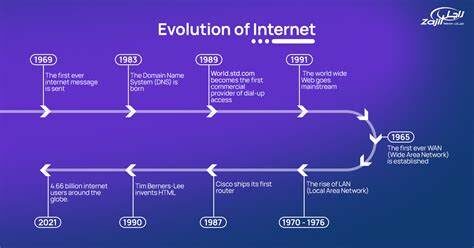Viral Gists
History Of The Internet: How It Came Into Existence, All You Need To Know
The history of the internet, a comprehensive blog post to explain how the global networking works with billions of users.
Table of Contents

The Internet, an integral part of modern life, has revolutionized communication, commerce, education, and entertainment. But how did the Internet come into existence? This comprehensive blog post delves into the fascinating history of the Internet, highlighting key milestones and pivotal moments that have shaped our digital world.
Early Beginnings: Conceptual Foundations
The idea of a global network and Internet access can be traced back to the 1960s. Researchers and visionaries like J.C.R. Licklider of MIT conceptualized the “Intergalactic Computer Network,” which envisioned a globally interconnected set of computers where everyone could quickly access data and programs from any site. This concept laid the groundwork for what would evolve into the Internet.
READ ALSO- Why Are iPhones Called iPhone And Not Other Names? Truth Unfolds
ARPANET: The Birth of a Network
The Advanced Research Projects Agency Network (ARPANET), funded by the U.S. Department of Defense, is often heralded as the precursor to the Internet. Launched in 1969, ARPANET was designed to facilitate communication between research institutions.
The first message was sent from UCLA to Stanford Research Institute, although the system crashed after the first two letters. Despite this rocky start, ARPANET proved the feasibility of packet-switching technology, which breaks data into packets for efficient transmission.
Packet Switching: The Backbone of the Internet
Packet switching, developed independently by Paul Baran and Donald Davies, is a method of grouping data into packets that are transmitted over a digital network. This revolutionary technology allowed multiple users to share the same network infrastructure, making data transmission more efficient and robust. Packet switching became the backbone of ARPANET and, subsequently, the Internet.
The TCP/IP Protocol Suite: Unifying Networks
In the 1970s, the need for a standardized communication protocol became apparent. Vint Cerf and Bob Kahn developed the Transmission Control Protocol/Internet Protocol (TCP/IP), which standardized data transmission across diverse networks. TCP/IP was adopted by ARPANET in 1983, marking a significant step toward the modern Internet. This protocol suite allowed different types of computers on other networks to communicate seamlessly.
From ARPANET to the Internet
The term “internet” was first used in the early 1980s to describe a network of networks interconnected by TCP/IP. ARPANET expanded to include more institutions, and other networks, like NSFNET (National Science Foundation Network), began to emerge. NSFNET became the backbone of the Internet in the mid-1980s, connecting academic and research institutions across the United States.
The World Wide Web: A User-Friendly Interface
While the Internet-connected computers, it was the World Wide Web (WWW) that made it accessible to the masses. Invented by Sir Tim Berners-Lee in 1989, the WWW is a system of interlinked hypertext documents accessed via the Internet. Berners-Lee developed the first web browser and server, enabling users to view and navigate web pages through hyperlinks. The introduction of the WWW in the early 1990s sparked a surge in internet use, transforming it into a user-friendly platform for information sharing.
Commercialization and Growth
The 1990s saw the commercialization of the Internet, with the introduction of web browsers like Mosaic and Netscape Navigator, which made the web more accessible to the general public. Developing e-commerce platforms, search engines, and social media further fueled the Internet’s growth. Companies like Amazon, Google, and Facebook emerged, transforming the Internet into a commerce, information, and social interaction hub.
The Mobile Revolution
The advent of smartphones and mobile Internet in the 2000s brought the Internet into the palms of billions worldwide. Mobile devices and wireless technology have enabled constant connectivity, reshaping how we communicate, work, and entertain ourselves. The proliferation of apps and mobile-friendly websites has made the Internet an indispensable part of daily life.
The Internet Today and Beyond
Today, the Internet is a global network of billions of devices, facilitating instantaneous communication and access to vast information. Cloud computing, IoT (Internet of Things), and AI (Artificial Intelligence) continuously expand their capabilities. As we look to the future, advancements like 5G, quantum computing, and blockchain promise to further revolutionize the Internet, making it faster, more secure, and more integrated into every aspect of our lives.
Conclusion
The Internet’s journey from a theoretical concept to a global phenomenon is a testament to human ingenuity and the relentless pursuit of connectivity.
Follow us on socials → Telegram | X/Twitter | Facebook | WhatsApp |WhatsApp Channel |Mobile App
Understanding its history highlights the technological advancements that have shaped our world and underscores the importance of innovation in driving progress. As the Internet continues to evolve, it remains at the forefront of shaping a connected and informed global society.
History of the Internet, ARPANET, TCP/IP protocol, packet switching, World Wide Web, Tim Berners-Lee, commercialization of the Internet, mobile revolution, evolution of the Internet future.











